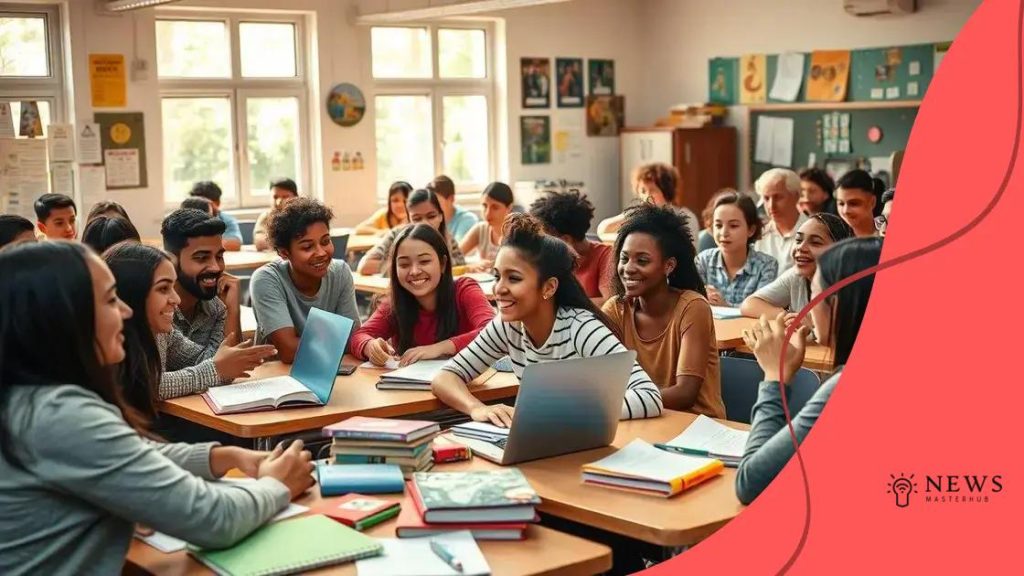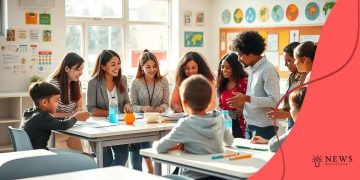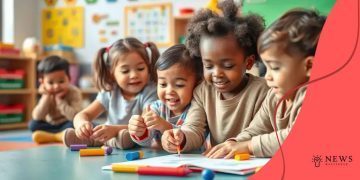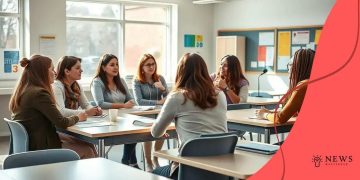Neuroscience and learning: integrating brain science into education

Anúncios
Neuroscience and learning focus on integrating brain science into K-12 curriculum to enhance teaching strategies, personalize student experiences, and promote effective learning outcomes through understanding cognitive processes.
Neuroscience and learning are becoming closely intertwined, opening new avenues for enhancing K-12 education. Have you ever wondered how understanding the brain can transform teaching methods? In this article, we dive into innovative practices that harness brain science to improve student experiences.
Understanding the basics of neuroscience
Understanding the basics of neuroscience is essential for educators who aim to enhance the learning experience. By exploring how the brain functions, teachers can develop methods that align with students’ natural learning processes.
Anúncios
Neuroscience reveals key insights about how memories are formed and retained. For instance, learning occurs through the creation of neural connections. When we practice a skill or encounter new information, our brains work to strengthen these connections, making recall easier.
Key Principles of Neuroscience in Learning
Here are some fundamental principles that educators should consider:
- **Neuroplasticity**: The brain can reorganize itself, which means that with practice, students can improve their abilities.
- **Emotional Connection**: Emotions play a big role in learning. Engaging students emotionally can enhance their retention of information.
- **Active Learning**: Instead of passively receiving information, students benefit from actively engaging with material, such as through discussions and hands-on activities.
Teachers can implement these principles in their daily lessons. For instance, using group activities can tap into students’ need for social interaction while applying the principles of neuroscience. This approach not only keeps students engaged but also enhances their understanding and retention.
Anúncios
Another important aspect of neuroscience is the impact of rest and nutrition on brain function. Sleep is crucial for memory consolidation. Therefore, encouraging students to prioritize sleep can significantly influence their academic performance. Furthermore, a balanced diet rich in nutrients can support cognitive function and overall brain health.
Incorporating these scientific insights into teaching strategies can help create a more effective learning environment. By understanding how the brain works, educators can tailor their approaches to support different learners better. This not only aids in catering to diverse needs but also encourages a more engaged and motivated classroom.
How brain science informs learning processes
How brain science informs learning processes is an exciting area of research that reveals how our brains develop and process information. Understanding these mechanisms allows educators to create effective teaching strategies that enhance student learning.
Brain science shows that different types of learning engage specific areas of the brain. For example, when students work on memorization, pathways related to recall and memory consolidation are activated. This is why practicing information multiple times helps strengthen those connections.
Types of Learning and Their Brain Impact
Here are some types of learning and their effects on the brain:
- Visual Learning: Information presented visually can stimulate associated brain regions, aiding memory retention.
- Auditory Learning: Hearing information, like listening to discussions, activates different pathways that can reinforce understanding.
- Kinesthetic Learning: Hands-on activities promote motor skill development and engage more areas of the brain, making learning fun and effective.
Incorporating these insights into classroom practice can lead to improved outcomes. When teachers apply varied methods—like combining visuals, sounds, and activities—they cater to the diverse needs of students. This not only helps keep students engaged but also fosters a deeper understanding of the material.
Brain science also highlights the importance of feedback in learning. When students receive constructive feedback, it activates their brain’s reward centers, encouraging them to continue improving. This is crucial for developing a growth mindset, where students see challenges as opportunities for learning rather than obstacles.
Furthermore, understanding the role of emotions in learning is vital. Positive emotions can enhance memory formation and retrieval, while negative emotions can inhibit the learning process. This means creating a supportive classroom environment is not just beneficial but essential for effective learning.
Practical strategies for K-12 educators

Implementing practical strategies for K-12 educators can drastically enhance student learning and engagement. Educators who understand how to apply neuroscience principles in the classroom can create an environment that promotes effective learning.
One fundamental approach is the incorporation of active learning. This technique encourages students to participate actively rather than passively listening. For instance, educators can facilitate group discussions, hands-on projects, and collaborative problem-solving activities. These methods engage different parts of the brain, fostering deeper understanding and retention.
Diverse Teaching Methods
Another effective strategy is to use diverse teaching methods tailored to students’ varied learning styles:
- Visual Aids: Infographics, diagrams, and videos can help visual learners grasp complex concepts.
- Interactive Technology: Utilizing apps and online resources can engage tech-savvy students, making lessons more dynamic.
- Storytelling: Integrating narratives into lessons can captivate students’ attention while making learning relatable.
In addition to these methods, providing timely and constructive feedback is crucial. Feedback helps students understand their progress and the areas they need to improve. By fostering a growth mindset, educators can encourage resilience and motivation in their students.
Another powerful strategy is creating a supportive learning environment. This involves building strong relationships with students and encouraging open communication. When students feel safe and valued, they are more likely to engage in class activities and take risks in their learning.
Integrating mindfulness practices into the classroom can also be beneficial. Activities like short meditation or breathing exercises can help reduce anxiety and improve focus. This promotes a better learning atmosphere, allowing students to absorb information more effectively.
Integrating neuroscience into lesson planning
Integrating neuroscience into lesson planning is a powerful way to enhance student learning outcomes. By applying brain science concepts, educators can create lesson plans that cater to how students learn best.
One effective approach is to align lesson objectives with how the brain processes information. For instance, breaking down complex concepts into smaller, manageable pieces can help students grasp topics better. This strategy recognizes the brain’s capacity for chunking information, making learning less overwhelming.
Strategies for Effective Integration
Here are some practical strategies for integrating neuroscience into lesson planning:
- Use Variety in Teaching Methods: Incorporate different teaching modalities like visuals, auditory instructions, and hands-on activities. This caters to diverse learning styles and keeps students engaged.
- Promote Active Engagement: Structure lessons to include discussions, group work, and problem-solving tasks. Engaging students actively helps reinforce their understanding through experience.
- Incorporate Breaks: Schedule short breaks during lessons to allow students to recharge. Research shows that short breaks can improve focus and retention, as they prevent cognitive overload.
Additionally, considering the role of emotions in learning is essential. When planning lessons, educators should strive to create an environment that fosters positive emotions. Activities that connect new information to students’ interests or personal experiences can enhance emotional connections, making the learning experience more impactful.
Another critical aspect is the use of formative assessments. Regularly checking for understanding helps teachers adjust their instruction based on student needs. Feedback can reinforce learning and encourage a growth mindset, supporting ongoing progress.
Lastly, establishing clear and achievable goals within lesson plans aids in maintaining motivation. When students know what to expect and can foresee their success, they are more likely to engage actively and strive toward achieving their objectives.
Future trends in educational neuroscience
Future trends in educational neuroscience promise to reshape how we teach and learn. As research progresses, new insights into brain function, learning processes, and educational applications will emerge, providing opportunities to enhance educational practices.
One significant trend is the growing integration of technology in the classroom. Advances in neuroscience are driving the development of educational technology that adapts to individual learning needs. For instance, software that uses algorithms to tailor learning experiences based on a student’s progress can provide personalized support.
Innovative Approaches to Learning
There are several innovative approaches anticipated to gain traction in education:
- Gamification: Introducing game-like elements into learning can increase motivation. By making learning fun and interactive, students are more likely to engage deeply with the content.
- Virtual and Augmented Reality: These technologies will offer immersive experiences, allowing students to visualize and interact with concepts in ways that traditional methods cannot.
- Neurofeedback: This technique involves using real-time displays of brain activity to teach self-regulation strategies, helping students manage attention and emotional responses.
Additionally, there is a growing emphasis on social-emotional learning (SEL). Understanding the brain’s role in emotions and social interactions is crucial for developing effective SEL programs. Schools are beginning to implement strategies that promote emotional intelligence, resilience, and empathy among students.
Collaboration among educators, neuroscientists, and psychologists is vital for translating research findings into practical classroom strategies. This interdisciplinary approach will ensure that educational practices are grounded in solid scientific evidence, leading to better outcomes for students.
Finally, as we explore the implications of neuroscience in education, ethical considerations will become increasingly important. Ensuring that neuroscience is applied fairly and equitably in all educational settings is crucial. Addressing potential disparities in access to new technologies and resources will help create a more inclusive learning environment for all students.
neuroscience into education offers exciting possibilities for enhancing learning. By understanding how the brain works, educators can create more effective lesson plans that cater to diverse learning styles. Future trends, such as the use of technology, active learning, and social-emotional strategies, promise to make education more engaging and impactful. As we move forward, it’s essential to ensure that these advances are accessible and promote equity in education, helping all students thrive.
FAQ – Frequently Asked Questions about Neuroscience and Learning in Education
How can integrating neuroscience improve my teaching methods?
Integrating neuroscience helps educators understand how students learn, enabling them to create more effective lesson plans that cater to diverse learning styles.
What role does technology play in future education trends?
Technology enables personalized learning experiences by adapting to individual student needs, making education more engaging and effective.
Why is social-emotional learning important in the classroom?
Social-emotional learning promotes emotional intelligence and resilience, which are crucial for students’ overall development and academic success.
How can teachers ensure equity in neuroscience-based education?
Teachers can ensure equity by providing access to resources and technologies that support all students, regardless of their background.





